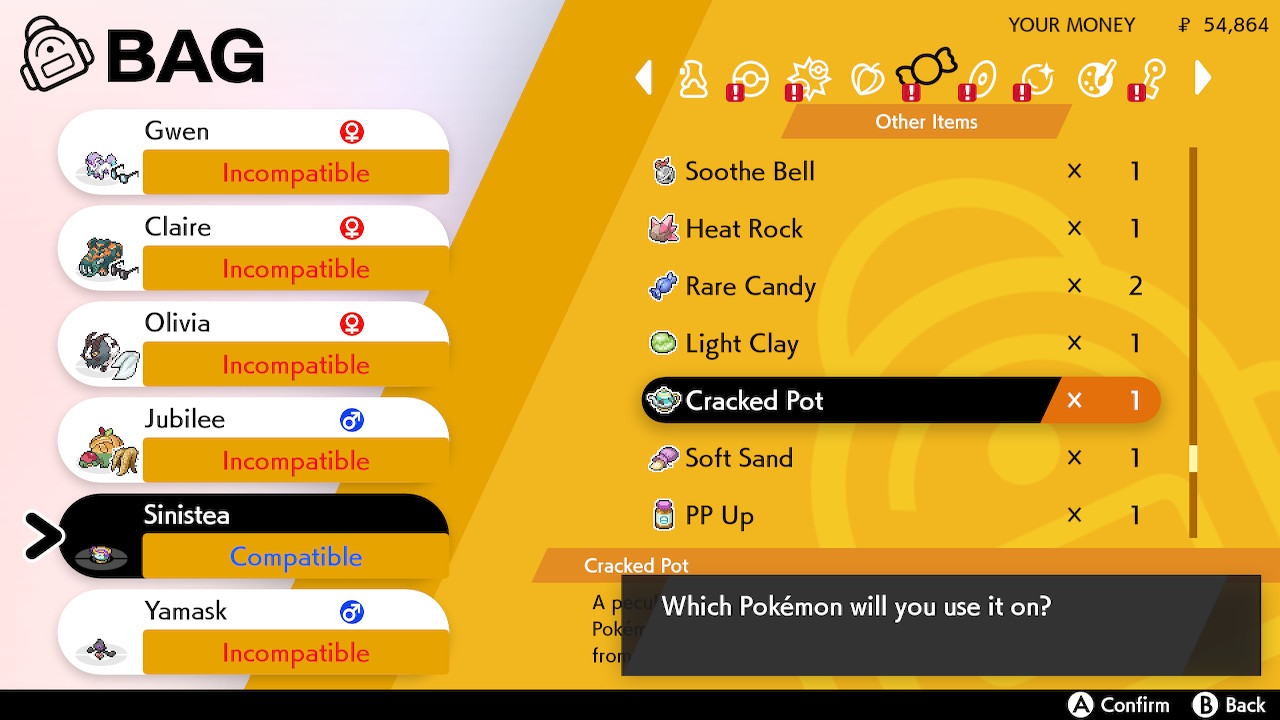Pokemon Sword and Shield: How to tell if your Sinistea is phony

If you've reached the Glimwood Tangle in Pokemon Sword and Shield, you may have encountered an unusual creature called Sinistea -- a ghost-type Pokemon inhabiting a teacup. What you may not know, even if you've captured one, is that there are subtle differences between Sinisteas, with most of these Pokemon being considered "phony" and a rare handful counting as "antique."
Never fear, all Pokemon are equally valid and strong. But if you want the rarest of the rare Sinisteas, here's everything you need to know about phony and antique Sinisteas:
What does it mean for a Sinistea to be phony or antique?

The ghost-type Pokemon Sinistea is actually a ghost haunting a teacup. And like actual teacups, some of these pieces of porcelain are more valuable than others. Every Sinistea you encounter has a rare chance to be an "antique" Sinistea, while the rest are considered "phony." The actual rarity is uncertain, with different sources giving numbers ranging from 1 in every 10 all the way to 1 in every 100. From our personal experience, it's somewhere in between the two. There's no way to guarantee you'll get an antique Sinistea, or increase your chances.
The differences between phony and antique Sinistea are twofold: there's a slight cosmetic difference (that carries over into its evolution, Polteageist), and there's a difference in how it evolves. Its stats, abilities, moves, and everything else are all the same. If your concern is to get the strongest Sinistea you can, you don't need to worry about its authenticity. But if you just want a rare Pokemon to show off to your friends, pursuing an antique Sinistea can be a fun challenge.
How can you tell if your Sinistea is phony?

There are two simple ways to tell if your Sinistea is phony or antique: the first is a visual one. Unfortunately, there's no way to tell until you've already caught the Pokemon, so if you're farming for authentici-tea, you'll need to keep capturing them.
Once you have a Sinistea, you want to check, open the PokeDex and check out the entry for Sinistea. Go to "Motion/Cry" and rotate the Pokemon model to look at its bottom. If your Sinistea is phony, you'll see nothing but the bottom of the cup. If it's antique, you'll see a tiny, faint, blue mark along the bottom inside rim of the cup. The same mark will appear on a Polteageist that's evolved from an antique Sinistea, or that is antique on its own and captured in a Max Raid battle.
Additionally, antique Sinistea has a slightly different Pokedex entry than a phony one. Though seeing a second entry is a way to signal you have had an antique Sinistea at some point, this entry will remain even if you trade away the Sinistea and does not indicate which one of your Sinisteas is the antique.
iMore offers spot-on advice and guidance from our team of experts, with decades of Apple device experience to lean on. Learn more with iMore!
Evolving your antique Sinistea

Sinistea is pretty easy to evolve, requiring a Cracked Teapot from a vendor in Stow-on-Side that pretty much only sells Cracked Teapots. Simply use the Cracked Teapot on your Sinistea, and it will evolve into Polteageist immediately.
However, you'll find this method does not work for antique Sinisteas. Antique Sinisteas will only evolve when exposed to a Chipped Teapot -- a different item. You can get the Chipped Teapot in the same way, from the same street vendor, but he only sells them rarely. You can check every day to see his current stock, his stock from the previous day, and what he'll be stocking tomorrow, but you'll need to be diligent if you've managed to get an antique Sinistea and want it to evolve into an antique Polteageist.
That said, the evolution method is another fast way to determine if your Sinistea is phony or authentic. Simply open your items menu and hover over a Cracked Teapot in your inventory. If it says "Compatible" beneath your Sinistea, it's a phony. If it says "Incompatible," then congrats! You have an antique Sinistea.
What about a shiny antique Sinistea?
Good luck! Shiny Pokemon are already super rare, so if you have the luck to encounter a shiny Sinistea or Polteageist, the odds of it also being antique are off the charts. It's probably not worth your time to try to hunt specifically for a shiny antique Sinistea, but a regular antique Sinistea on its own is a doable pursuit.
Where can I catch Sinistea?

Sinistea is found in the Glimwood Tangle through surprise encounters only, which means you'll be running from a lot of Shiinotics and Phantumps while you hunt for it. You can also find Polteageists in Max Raid Battles in the Wild Area sometimes, which equally have the same chance to be phony or antique (but with the bonus that you don't have to mess with evolving them).
Any questions?
Be patient, Sinistea enthusiasts! You'll get your hands on an authentic Sinistea with some determination, and even be able to evolve it with time. If you're still unsure about the authenticity of your Sinistea, let me know in the comments below.


